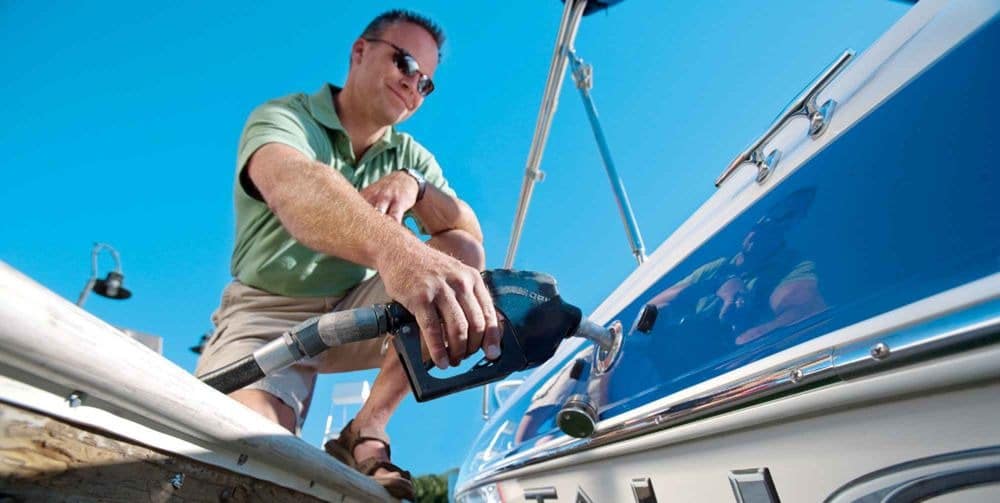
High anxiety? Nothing brings it on faster than a fuel leak aboard a boat. This happened to me a few years ago when I found gasoline streaming into the bilge. Everything else became secondary to stemming the flow of loose go-juice. What I learned might help if you’re faced with a similar situation.
1. Move Quickly
Procrastination can have major consequences, ranging from a fuel spill (and costly fine) to a catastrophic explosion and fire.
2. Turn on the Bilge Blower
If your boat has a bilge blower, use it to clear out fumes. Yet be sure the blower fan is indeed rated for ignition projection, as required by the American Boat and Yacht Council (ABYC).
3. Open All Hatches
It’s important to prevent fumes from accumulating. So remove any shrink-wrap or boat covers and prop open all hatches to air out the bilge, regardless of whether you have a bilge blower or not.
4. Close All Fuel Valves
If the leak is downstream of the valve, this will stem the flow. If the flow stops after a valve is closed, it can also help you zero in on the location of the leak.
5. Avoid Ignition Sources
While marine pumps and motors are ignition protected (meaning they will not emit an open spark), items such as drill motors, power drivers and jigsaws are not. So don’t use these — or allow anyone to smoke or light a match — near the boat until the leak is fixed and the fuel has been cleaned up. And dont use your mobile device!
6. Find the Leak
This might be easier said than done. In my case, corrosion had eaten away at the bottom of the aluminum fuel tank, leaving pinholes. There was no way to see the leak. In other cases, such as a rotten hose or cracked fuel fitting, you might be able to find the leak right away.
7. Contain the Spill
It is illegal to dump fuel, oil or other contaminants into waterways, so don’t use your bilge pump to jettison fuel. Likewise, if your boat’s on a trailer, don’t dump fuel onto the ground. Use absorbent pads to soak up the fuel, and then carry them in buckets to a hazardous-waste disposal site. Your marine patrol or marina manager can point you to the closest one. When transporting the soaked pads, avoid carrying them in an enclosed space such as a car trunk where fumes can accumulate.Instead, use the open bed of a pickup truck.
8. Drain the Tank
If the fuel tank is leaking, you’ll need to empty it quickly to stem the leak. You can drain it by disconnecting the fuel line downstream of the fuel tank. With the boat on a trailer or on blocks, you can also siphon it out by feeding a hose down the fuel fill. In either case, place the other end of the hose below the fuel tank. Connect a primer bulb to the hose to get the fuel flowing.
9. Contain the Fuel
If you’re draining the tank, estimate the volume of fuel and have an equivalent volume of fuel containers standing by. As one is filling, have the next one at the ready to minimize spillage. Use metal containers, because ungrounded plastic fuel containers tend to generate static electricity as fuel is flowing into them.
10. Dispose of the Fuel
This is the easy part. Find a neighbor who needs fuel for his boat or vehicle and offer to fill his tank. Or you can keep the fuel to refill your tank once it has been repaired or replaced. For the latter, add stabilizer to help prevent the fuel from going bad while it is in storage.
Finally, I am reminded by Boating contributor and ABYC Vice President/education director Ed Sherman that under ABYC standards, fuel system inspections for leaks are recommended annually, if not more frequently, instead of the first time you smell fuel.
Quick Tip: Clean the bilge with a product like Star brite Heavy Duty Bilge Cleaner ($10.90; wholesalemarine.com).
* * * * *
The U.S. Coast Guard is asking all boat owners and operators to help reduce fatalities, injuries, property damage, and associated healthcare costs related to recreational boating accidents by taking personal responsibility for their own safety and the safety of their passengers. Essential steps include: wearing a life jacket at all times and requiring passengers to do the same; never boating under the influence (BUI); successfully completing a boating safety course; and getting a Vessel Safety Check (VSC) annually from local U.S. Coast Guard Auxiliary, United States Power Squadrons(r), or your state boating agency’s Vessel Examiners. The U.S. Coast Guard reminds all boaters to “Boat Responsibly!” For more tips on boating safety, visit www.uscgboating.org.








